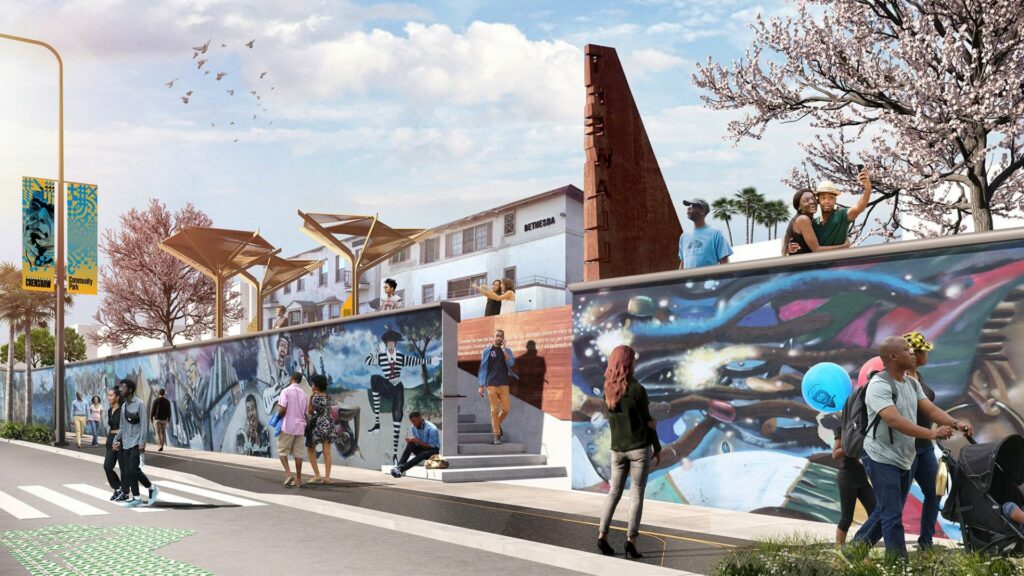
News
By Helen Hope, May 4, 2021
The following is one of nearly 50 case studies included in the newly updated creative placemaking guide, the Scenic Route. This resource provides a tour of eight common approaches used in exemplary projects across the country at the intersection of arts, culture, and transportation.
Join Smart Growth America, Transportation for America, and the National Endowment for the Arts on Monday, May 10th at 3 p.m. Eastern to hear from experts on why this guide matters and how you can use it in your community. In the meantime, check out the Scenic Route at transportation.art.

A community-led project aims to help local residents see themselves in new infrastructure and introduce visitors to the local Black neighborhood history in Hyde Park, Los Angeles
The challenge
Hyde Park, one of the oldest communities in Los Angeles, is a working-class neighborhood with relatively low levels of college education and many single parent households in the heart of Black Los Angeles. While the neighborhood has lacked connections to the city’s growing network of rail lines, that will change soon as the Los Angeles County Metropolitan Transportation Authority (Metro) is hard at work on the new Crenshaw-LAX (C-LAX) transit corridor that will connect Hyde Park (and Crenshaw Boulevard) to the Los Angeles International Airport. More than a decade ago, Los Angeles voters approved Measure R, creating a new sales tax to support transportation improvements, including 12 new transit projects. In 2014, construction began on the C/LAX project.
Parts of C/LAX were engineered to run underground, others on an elevated rail line, and some at street level. The portion running through Hyde Park and Leimert Park (the heart of Los Angeles’ Black community, which is one of the largest Black communities west of the Mississippi) will run at grade. This required the removal of hundreds of mature trees and disruption to the many businesses along this important Black commercial corridor.
These direct connections to the airport and the rest of the city will provide Hyde Park residents with greater mobility, and employment and education opportunities. But in today’s climate where businesses and residents alike are clamoring to be in places that are well-connected to transit, real estate in close proximity to light rail will also become much more attractive to investors.
Destination Crenshaw
Community leaders responded to this perceived slight by organizing around a vision for this 1.3-mile stretch of the light-rail line, focused on turning it into an “outdoor art and culture experience celebrating Black Los Angeles.” This vision became Destination Crenshaw, a community-led project with the dual goals of helping local residents see themselves in the new infrastructure and introducing visitors to the culture and history of the Black neighborhoods they’re passing through. Led by Councilmember Marqueece Harris-Dawson, Destination Crenshaw’s leaders explain the goals of the project as follows:
“Serving as an economic incubator for residents and legacy businesses, Destination Crenshaw is an outdoor people’s museum that’s countering the forces of gentrification and cultural erasure that threaten our community. This first-of-its-kind project will preserve the culture and historic contributions of Black Los Angeles by increasing a sense of community ownership.”
Destination Crenshaw’s design team is led by Perkins and Will; 20 community partners advise on the project. Construction of Destination Crenshaw began in February 2020. When complete, the project will include more than 100 works of public art created by nationally and internationally known Black artists, more than 1,000 new trees, and over 30,000 square feet of green space.

Heart of Hyde Park
Concurrent with Destination Crenshaw, a community-based team led by LA Commons, lead artist Moses Ball, associate artist Dezmond Crocket, and the AFIBA Center created a series of murals entitled the “Heart of Hyde Park.”
The mural highlights local heroes and the multicultural heritage of Hyde Park, and was created as a synthesis of youth artist sketches after they interviewed local community members who shared stories about their upbringing, personal journeys through adulthood ranging from entrepreneurship to raising a family, local history, and regional history that shed light on the African influence in MesoAmerica.
The project supported LA Metro’s vision to create “transit-oriented communities” (TOCs), an approach to development focused on compact, walkable and bikeable places in a community context (rather than focusing on just a single development parcel). It’s critical to foster a community-based response to such investment during early planning phases that align with and highlights the unique assets and identity of the area. Using arts and culture, LA Commons contributed to crafting these transit oriented communities around the new station.
The Heart of Hyde Park mural project also organized and prepared community members to engage with the larger Destination Crenshaw project, and with LA Metro on infrastructure projects more broadly.
This text is adapted from a piece that originally appeared in FORWARD Issue #2: Transportation, and has been reposted here with permission from Forecast Public Art.
To see all of the Scenic Route case studies, head over to transportation.art
Related News

© 2025 Smart Growth America. All rights reserved
Site By3Lane Marketing


















